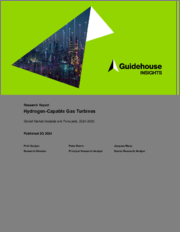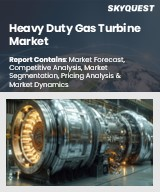
|
시장보고서
상품코드
1496648
수소 대응 가스 터빈Hydrogen-Capable Gas Turbines: Global Market Analysis and Forecasts, 2024-2033 |
||||||
송전 가능한 저탄소 발전 기술의 활용은 탈탄소 전력 시스템에서 점점 더 중요한 요소로 부상하고 있습니다. 현재 많은 전력망은 유연성에서 중요한 역할을 하는 천연가스 발전기에 의존하고 있습니다. 전력 부문의 화석 연료 소비를 줄이기 위한 노력으로 전통적인 가스 화력 발전의 대안으로 수소 또는 수소-천연가스 혼합 연소 가스 터빈에 대한 관심이 높아지고 있습니다.
기존 가스 터빈 중 일부는 이미 수소 함량이 높은 가스 스트림을 소비하고 있습니다. 그러나 그 도입은 일반적으로 정유 및 기타 산업 공정의 부산물 가스가 공급되는 소규모 시설에 국한되어 있습니다. 주요 가스 터빈 제조업체들은 제품군 전반에 걸쳐 혼합 능력을 향상시키고 2030년대 또는 그 이전에 100% 수소 가스 터빈을 상용화할 계획을 발표했습니다. 이러한 노력은 미국, 독일, 일본, 한국 등 주요 시장에서 수소 발전에 대한 정책적 지원으로 지원되고 있습니다.
전력 부문에서 사용할 수 있는 전체 수소의 양은 여전히 불확실성이 높지만, 향후 10년간 수소 기반 가스터빈은 발전 설비 판매량에서 차지하는 비중이 점점 더 커질 것으로 예상됩니다. 이 보고서는 세계 수소 지원 가스터빈(HGT) 시장을 분석하고 향후 10년간 도입에 영향을 미칠 것으로 예상되는 주요 기술적, 상업적, 정책적 요인에 대한 개요를 제공합니다. 시장 예측은 계획된 수소 발전 용량과 수소 기술 도입에 대한 제조업체의 타임라인 분석을 기반으로 합니다.
목차
제1장 주요 요약
제2장 시장의 문제
- 서론
- 시장 촉진요인
- HGT 개조에 의해 기존 인프라의 변환이 실현
- HGT에 의한 재생에너지 단속성의 완화와 그리드 안정성의 제공
- 정부의 자금 원조에 의한 조기 참여의 실현
- 시장 억제요인
- 연료 유연성에 의한 기술적인 과제
- 수소 공급망 발전의 필요성
- 공급망의 모든 단계에서의 에너지 손실
- 기타 비즈니스상 문제
제3장 정책 재고
- 북미
- 미국
- 유럽
- 독일
- 아시아태평양
- 일본
- 한국
- 싱가포르
- 호주
- 라틴아메리카
- 중동 및 아프리카
제4장 산업 밸류체인
- 경쟁 구도
- 상위 3사
- 기타 OEM
제5장 시장 예측
- 조사 방법
- 세계 시장 개요
- 북미
- 유럽
- 아시아태평양
- 라틴아메리카
- 중동 및 아프리카
제6장 결론·제안
- 주요 포인트
- 권장사항
제7장 두자어·약어 리스트
제8장 도표
제9장 조사 범위, 정보원·조사 방법, 주석
KSA 24.06.27The availability of dispatchable, low carbon power generation technologies is an increasingly relevant feature of decarbonizing electricity systems. Currently, many power grids rely on natural gas generators to play a key flexibility role. Efforts to reduce power sector fossil fuel consumption are driving interest in gas turbines capable of operating using hydrogen or hydrogen-natural gas blends as an alternative to conventional gas-fired generation.
A portion of the existing gas turbine fleet already consumes hydrogen-rich gas streams. However, deployments are generally limited to smaller-scale equipment supplied with by-product gases from petroleum refining or other industrial processes. Major gas turbine manufacturers have announced plans to increase blend capabilities across their product ranges and to commercialize 100% hydrogen gas turbines by the 2030s or earlier. These efforts are being assisted by policy support for hydrogen power generation in key markets such as the US, Germany, Japan, and South Korea.
While overall volumes of hydrogen available to the power sector remain subject to high levels of uncertainty, hydrogen-capable gas turbines are expected to account for an increasingly meaningful share of power generation equipment sales over the coming decade. This Guidehouse Insights report provides an overview of the key technical, commercial, and policy factors that are likely to affect adoption over the next 10 years. Forecasts are based on an analysis of planned hydrogen power generation capacity and manufacturers' timelines for hydrogen technology adoption.
Table of Contents
1. Executive Summary
- 1.1 Market Introduction
- 1.2 Global Outlook
2. Market Issues
- 2.1 Introduction
- 2.2 Market Drivers
- 2.2.1 HGT Retrofits Enable the Conversion of Existing Infrastructure
- 2.2.2 HGTs Can Buffer Intermittent Renewables and Provide Grid Stability
- 2.2.3 Government Funding Has Enabled Early Movers
- 2.3 Market Barriers
- 2.3.1 Fuel Flexibility Presents Technical Challenges
- 2.3.2 Hydrogen Supply Chains Need Further Development
- 2.3.3 Energy Is Lost with Every Step in the Supply Chain
- 2.4 Other Business Issues
3. Policy Review
- 3.1 North America
- 3.1.1 US
- 3.2 Europe
- 3.2.1 Germany
- 3.3 Asia Pacific
- 3.3.1 Japan
- 3.3.2 South Korea
- 3.3.3 Singapore
- 3.3.4 Australia
- 3.4 Latin America
- 3.5 Middle East & Africa
4. Industry Value Chain
- 4.1 Competitive Landscape
- 4.1.1 The "Big Three"
- 4.1.1.1 GE
- 4.1.1.2 Siemens Energy
- 4.1.1.3 Mitsubishi Power
- 4.1.2 Other OEMs
- 4.1.1 The "Big Three"
5. Market Forecasts
- 5.1 Methodology
- 5.2 Global Market Overview
- 5.2.1 North America
- 5.2.2 Europe
- 5.2.3 Asia Pacific
- 5.2.4 Latin America
- 5.2.5 Middle East & Africa
6. Conclusions and Recommendations
- 6.1 Key Takeaways
- 6.2 Recommendations




















